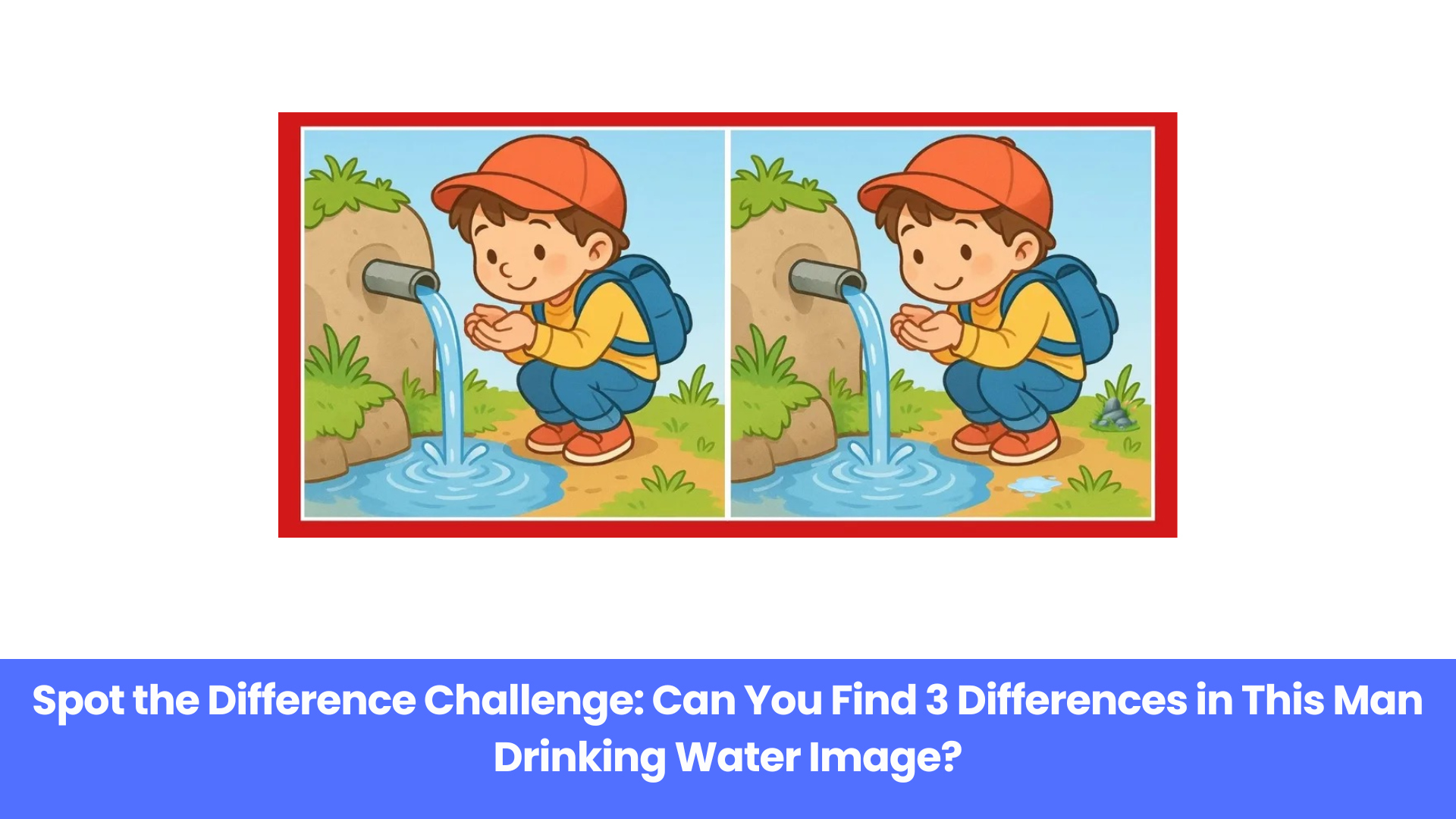Are you ready to test how sharp your eyes really are? A new Spot the Difference Challenge is trending online, featuring two almost identical images of a man drinking water. But here’s the twist — three small differences are hidden in the pictures, and you have only 9 seconds to find them! This visual puzzle is a perfect mix of fun and focus, testing both your observation and speed.
Why This Puzzle Is So Difficult
At first glance, both images look exactly the same. The man’s pose, the water flow, and even the background appear identical. However, the challenge lies in the subtle visual changes that are easy to miss unless you look very closely.

The human brain tends to recognize familiar patterns quickly, skipping over small details. That’s why many people fail on their first try. These tiny edits are meant to confuse your visual perception and make your brain work harder to detect differences in shapes, lines, and background elements.
How to Spot Differences Quickly
To solve a spot-the-difference puzzle efficiently, you need a method rather than random guessing. Experts suggest dividing the image into sections and scanning one part at a time.
Start from the top of the image and slowly move downward. Compare the same features in both pictures — the man’s face, the stream of water, the ground, and the surrounding area. It’s also helpful to blink less and stay focused for those 9 seconds to notice even the smallest irregularities.
Remember: patience and systematic viewing will give you the edge over speed.
Revealing the 3 Hidden Differences
If you couldn’t spot all three differences in time, here’s what you missed:
- The Water Stream: In one image, the water stream flowing from the pipe appears broken in the middle, while in the other, it’s continuous. This change is so small that most people overlook it on the first look.
- The Man’s Nose: In the left image, the man’s nose is clearly visible, but in the other image, it’s missing completely. This small facial edit is one of the cleverest changes and catches your eye only after close inspection.
- Extra Stones Near the Grass: If you observe the ground carefully, you’ll notice additional stones near the grass area in one of the pictures. These stones are absent in the other image, making it the final difference.
Each difference tests a different aspect of observation — motion, human detail, and environmental awareness.
Why These Puzzles Are Good for Your Brain
Spot-the-difference puzzles are not just time-pass games — they are proven to boost mental sharpness and visual focus. When your brain searches for minor differences, it activates areas responsible for memory, attention, and pattern recognition.
These challenges help you stay alert, improve decision-making speed, and enhance concentration — skills that are valuable both in studies and professional work.
Benefits of Practicing Observation Games
Observation puzzles like this one come with several real-life benefits:
- Better focus: Helps in staying attentive to small details.
- Improved memory: Enhances your ability to remember visual patterns.
- Stronger problem-solving: Trains your brain to think logically under time pressure.
- Stress relief: A fun and relaxing way to refresh your mind after work or study.
Even a few minutes of visual challenge each day can help you become more observant in daily life.
Tips to Improve Your Spot-the-Difference Skills
If you love playing these puzzles and want to get better, here are a few simple techniques:
- Check one section at a time: Focus on smaller areas instead of the whole image.
- Use your side vision: Peripheral viewing can help catch changes in the background.
- Stay calm: Don’t rush—focus leads to accuracy.
- Practice regularly: The more you play, the better your eyes become at spotting patterns.
Conclusion
If you managed to find all three differences within 9 seconds, congratulations — you’ve got an amazing eye for detail! The small edits like the broken water stream, missing nose, and extra stones may seem simple, but they test real observation skills.
If you missed a few, don’t worry — practice makes perfect. These puzzles are not just about fun; they’re a mental workout that keeps your brain active, sharp, and alert. So, get ready for your next challenge and see how fast you can spot what others miss!
FAQs
What is a spot-the-difference puzzle?
It’s a visual game where you compare two similar images and try to find small differences between them.
Why are these puzzles good for the brain?
They improve focus, visual memory, and attention to detail by challenging your brain to notice subtle changes.
How can I solve these puzzles faster?
Work in sections, compare similar areas, and train your eyes to look for changes in colour, shape, or object placement.
How many differences were in this challenge?
There were three hidden differences — in the water stream, the man’s nose, and the stones near the grass.
Can kids play these puzzles too?
Yes! These challenges are suitable for all ages and help children improve focus and observation skills in a fun way.

